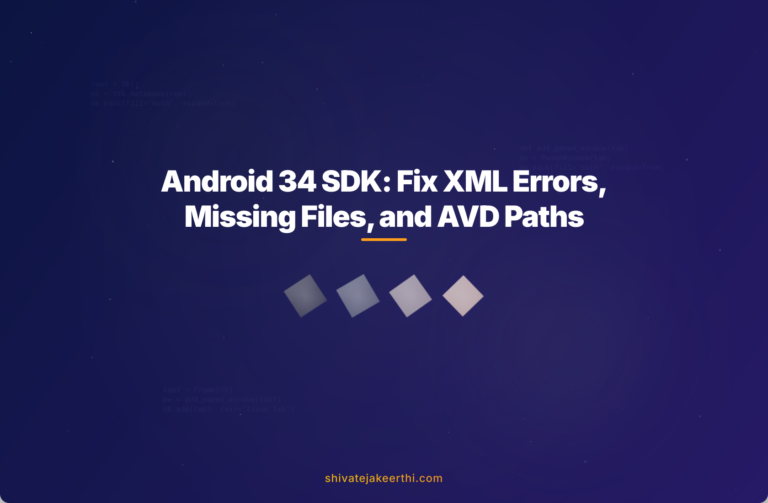If you’ve spent any time building Android apps, you’re likely very familiar with the excitement—and frustration—that accompanies each update of the Android SDK tools. Recently, Android developers upgrading to Android 34 have been encountering some particularly persistent installation hurdles: XML parse errors, missing configurations like repositories.cfg, and inconsistent or broken paths preventing AVD creation. These issues can halt your progress and disrupt your workflow, leaving you stuck for hours troubleshooting instead of coding.
Let’s break down these common problems step-by-step to find practical solutions to get you back on track.
XML Parse Errors: What’s Happening?
One of the earliest warnings many developers see during the update process is an XML parse error. The error typically surfaces when updating packages via the Android SDK Manager, often displaying vague messages about poorly formatted XML content in certain manifest files.
Though instinctively alarming, you might initially decide to proceed with the installation despite the warnings—in hopes the errors don’t affect your setup. But unfortunately, ignoring the errors rarely solves the root issue. More often, these parse errors stem from corrupted manifest files, incorrect Java versions, or outdated SDK tools.
Missing repositories.cfg and Package File Issues
Another notorious issue popping up frequently with Android 34 updates revolves around the absence of a file named repositories.cfg. The SDK Manager expects this configuration file in your SDK directory, typically at:
%USERPROFILE%\.android\repositories.cfg (Windows)
~/.android/repositories.cfg (Linux and macOS)If it’s missing, the SDK Manager might complain repeatedly. You might even find advice on forums like Stack Overflow discussions suggesting you manually create an empty file:
touch ~/.android/repositories.cfgYet, even after manually adding this file, some users report that their package listings remain incomplete or corrupted. Further investigation often reveals strange or incomplete contents inside existing manifests—potentially resulting from incomplete downloads or interrupted network connections during updates.
Can’t Install Android API 34 via SDK Manager? Here’s Why
After tackling XML parse errors and configuring repositories.cfg, you might next run into failure messages when installing Android-34 APIs themselves. Often, developers describe repeatedly selecting API level 34 via SDK Manager but seeing installation processes terminate unexpectedly or fail silently.
One possible reason is a mismatch between your installed tools and the required Java JDK version. Android SDKs typically require specific Java versions—such as OpenJDK 11—to function properly. Having multiple or conflicting Java versions can lead directly to installation failures or parsing errors.
Additionally, persistent XML parse errors during installation indicate deeper underlying issues like corrupted SDK package indexes (often XML files). Even repeated installations won’t fix the underlying cause unless you clear and refresh your cache or remove conflicting SDK and tool versions.
Broken AVD Paths and Emulator Issues
Finally, even if you successfully (or seemingly successfully) installed Android 34 APIs, running into the dreaded AVD errors can halt emulator creation abruptly. Frequently encountered errors look something like this:
Error Creating AVD:
Emulator: PANIC: Broken AVD system path. Check your ANDROID_SDK_ROOT value.This indicates that your SDK or emulator location settings aren’t lining up with reality—perhaps due to incorrect configurations or partial SDK installations. Common triggers here include partial or incorrect installations of SDK platform images or incomplete package downloads.
Troubleshooting Steps that Have Worked
Faced with these common, headache-inducing issues, it’s helpful to systematically perform a few targeted troubleshooting steps:
- Check and adjust Java versions: First, ensure you have OpenJDK 11 installed and configured correctly, as instructed in the official Android documentation. Conflicting Java versions frequently cause the XML parse errors noted above—so standardizing your JDK environment can often resolve multiple related errors simultaneously.
- Clear and reinstall the Android API: Removing problematic API folders (Android-34) under your SDK platforms folder and re-downloading them fresh is proven to help. You can even test it by reverting temporarily to a previously stable API like Android-30 to rule out general SDK Manager issues.
- Accept SDK licenses (again!): Sometimes, accepting or confirming licenses via the SDK Manager isn’t enough. Using command-line invocation can help explicitly ensure all licenses are accepted:
./sdkmanager --licensesDo it from your SDK tools bin directory to confirm everything is set properly.
- Set Environment Variables Properly: Make sure ANDROID_HOME or ANDROID_SDK_ROOT correctly point to your actual SDK installation directory. Incorrect or missing environment variables directly trigger broken AVD path issues. If unsure, verify your configuration with:
echo $ANDROID_HOME echo $ANDROID_SDK_ROOT
Limitations of Android Studio GUI Installation
You might wonder why you can’t simply rely on Android Studio’s built-in GUI installer. In enterprise setups or cloud environments without graphical interface support—or if you simply prefer lightweight setups using command-line tools—Android Studio GUI installations are simply not feasible.
The GUI installer, by nature, tends to handle these errors silently and more gracefully, streamlining many required setup steps. Without access to this installer, you become heavily reliant on properly configured manual installs—which is precisely why these XML and AVD path issues crop up more prominently.
If you find yourself stuck here, exploring Docker-based Android environments or manual command-line installations like sdkmanager commands becomes essential.
Additional Tips and Resources
Beyond these common fixes, you also may find assistance in community-driven environments:
- Stack Overflow: Great for specific error codes and interactive help.
- Android Developers page: Official documentation always has the latest troubleshooting updates.
- GitHub Issues: Search open issues repositories for shared problems and possible workarounds discussed by fellow developers.
Remember, challenges installing new SDK versions like Android 34 are common—and you’re not alone. Keeping thorough records of any errors you encounter and their exact messages can significantly expedite seeking support and uncovering solutions.
Have you encountered other installation stumbling blocks with your Android SDK setup? Any unique solutions you’ve found particularly helpful? Feel free to share your experiences below—we’d love to keep this troubleshooting conversation going!



0 Comments